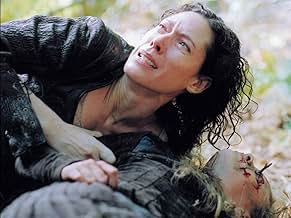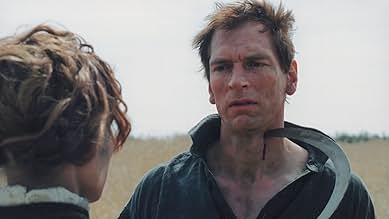An uproar is caused when some mutilated cadavers are discovered, giving way to the legend of the "Werewolf of Allariz". A traveling vendor rolls through the forest in his old wagon. A woman ... Read allAn uproar is caused when some mutilated cadavers are discovered, giving way to the legend of the "Werewolf of Allariz". A traveling vendor rolls through the forest in his old wagon. A woman from every village on his route faithfully awaits him. He's attractive, intelligent, charm... Read allAn uproar is caused when some mutilated cadavers are discovered, giving way to the legend of the "Werewolf of Allariz". A traveling vendor rolls through the forest in his old wagon. A woman from every village on his route faithfully awaits him. He's attractive, intelligent, charming.... But he's also the monster feared by all. His most recent prey, Barbara will soon b... Read all
- Director
- Writers
- Stars
- Awards
- 1 win & 8 nominations total
- Gómez
- (as Carlos Reig)
- Director
- Writers
- All cast & crew
- Production, box office & more at IMDbPro
Featured reviews
The film takes place in 1851, in a rural Spanish community where there has been a spate of deadly attacks, presumably by wolves. Travelling salesman Manuel Romasanta (played by the very English Julian Sands, who makes zero attempt at an accent) arrives in the area to visit his girlfriend Maru Valdivielso, who shares her home with her rather lovely sister Bárbara (Elsa Pataky) and their young deaf niece Teresa (Luna McGill).
Seemingly concerned for their safety, Manuel offers to escort Maria and Teresa to Santander, but the girls never make it to their destination, their charming travelling companion attacking them in the forest, believing himself to be a lycanthrope—a man who can transform into a wolf. When Manuel returns to Bárbara, he seduces the unsuspecting woman, but is unable to hide the truth for very long
With its mid-19th century European setting, ambiguous werewolf plot, and stunning visuals, Romasanta reminded me a lot of Christophe Gans' The Brotherhood of the Wolf; but like that film, Romasanta suffers from a plodding and slightly confusing narrative, one that makes matters hard going, even despite a few genuinely twisted moments involving sticks in eyes and the removal of body fat, a fairly decent transformation scene, and the sight of Pataky in a tin bath having her breasts soaped up by Sands.
But really I wouldn't bother watching this if I were you.
Julian Sands (Romasanta) is excellent in this chilling Gothic tale, portraying the character with such eerie class that makes the film as good as it is. This is no ordinary werewolf movie, it is a psychological thriller, looking at the mind-set of a man suffering from lycanthropy, making him turn mentally to a beast but making him feel the physicality of it.
All in all, an excellent Gothic tale, a new take on werewolf movies and I would say that it is better than most films involving werewolves. What's more, it is based on real events. Excellently filmed and acted, especially by Julian Sands. Definitely worth watching. From me, 9/10.
Cat §quire
The story of Manuel Blanco Romasanta is quite a well known one in Spain. It happened in the mid-nineteenth century, when a string of violent deaths took place which seemed in some ways like animal attacks, and in others like cold and calculated murder. Eventually a man was arrested -- Manuel Romasanta, and it was found that he used the body fat from his victims to make soap. At his trial he claimed that he became a werewolf, and that it is the nature of a wolf to kill. He was diagnosed with the psychological condition of lycanthropy, and given a life sentence rather than death.
The film itself is based largely on truth, partly on speculation and partly on pure invention for artistic purposes. It's certainly a lot closer to the truth than "Brotherhood of the Wolf" was, anyway. One character is knowingly invented, and some rather unlikely theories are put forward in the place of that which is unknown, but the question of whether or not Romasanta was actually a werewolf is left completely open. Paco Plaza appears to be a competent and innovative director, and the style of the film is really superb. It is quite slow moving, and arguably it's rather light on actual story and plot, but that's about as far as the criticism goes.
There are several great performances, but the standout comes from Julian Sands as the title character, who submerges himself in the role in the way that only outstanding actors can. John Sharian is also very good as the misguided, haunted 'partner' of Romasanta, and both Gary Piquer and David Gant are memorable in supporting roles as those who finally bring the murderer to justice. It also features Elsa Pataky as the leading heroine, who has become a huge sex symbol in Spain and it isn't hard to see why -- think along the lines of a Spanish Keira Knightley.
This is the finest historical werewolf film I've ever seen, and any self-respecting werewolf buff should take a look, but unfortunately there's not much chance of this one being a blockbuster.
Did you know
- TriviaBased on the case of serial killer Manuel Blanco Romasanta who murdered at least 13 people in 1850s Spain. He claimed a curse turned him into a wolf causing him to kill. Because of these claims, Queen Isabella II acquitted him, but he died in jail before being released. The Romasanta case previously inspired Carlos Martínez-Barbeito's novel "El bosque de ancines", filmed as El bosque del lobo (1970).
- GoofsWhen Barbara first holds the sickle to Romasanta's neck, a black safety cap is visible on the tip.
- Crazy creditsThe opening Filmax logo, usually a white sphere with three stripes (yellow, red and blue), turns into a full moon.
- ConnectionsEdited into Así se hizo 'Romasanta, la caza de la bestia' (2004)
- How long is Romasanta: The Werewolf Hunt?Powered by Alexa
Details
Box office
- Budget
- €4,500,000 (estimated)
- Gross worldwide
- $813,586
- Runtime1 hour 30 minutes
- Color
- Sound mix
- Aspect ratio
- 2.35 : 1
Contribute to this page































